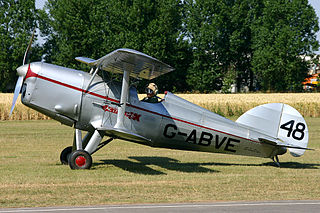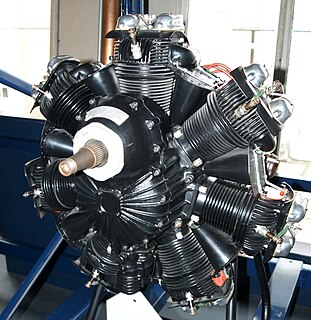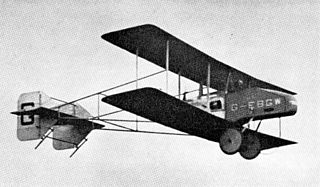
The ANEC I and ANEC II were 1920s British single-engine ultralight aircraft designed and built by Air Navigation and Engineering Company Limited at Addlestone Surrey. One was privately constructed in Brisbane, Australia.

The Arrow Active is a British aerobatic aircraft built in the 1930s.

The Comper C.L.A.7 Swift is a British 1930s single-seat sporting aircraft produced by Comper Aircraft Company Ltd of Hooton Park, Cheshire.
The Bristol Type 91 Brownie was a light sports aircraft produced in the United Kingdom by the Bristol Aeroplane Company in 1924. It was a low-wing cantilever monoplane aircraft of conventional configuration with fixed tailskid undercarriage. The pilot and passenger sat in tandem open cockpits. It won the £1,000 pound prize for second place at the Lympne light aircraft trials in October 1924.

The Pobjoy Niagara is a British seven-cylinder, air-cooled, radial, aero-engine first produced in 1934. The design ran at higher speeds than conventional engines, and used reduction gearing to lower the speed of the propeller. This led to a noticeable off-centre mounting for the propeller. The Niagara was a popular engine for light and experimental aircraft, well regarded due to its small diameter, smooth operation, low noise and innovative engineering.

The Avro 562 Avis was a two-seat light biplane designed and built by the A.V.Roe and Company Limited at Hamble for the 1924 Lympne Light Aeroplane Trials.

The Gloster Gannet was a single-seat single-engined light aircraft built by the Gloucestershire Aircraft Company Limited of Cheltenham, United Kingdom, to compete in the 1923 Lympne Trials. Engine development problems prevented it from taking part.
Nicholas Comper was an English aviator and aircraft designer, whose most notable success was the 1930s Comper Swift monoplane racer.

The Vickers Vagabond was Vickers' entrant for the second Lympne light aircraft competition, held in 1924. It was a conventional small biplane, with a very unusual method of trimming. It was eliminated from the trials at an early stage and only one was built.
The Beardmore Wee Bee was a single-engined monoplane built only once and specifically for the Lympne two-seat light aircraft trials held in the United Kingdom in 1924. This plane won the major prize.

The Cranwell CLA.3 was a parasol winged single-engined, single-seat British aircraft built to compete in the Lympne air races of 1925. It was designed and built by an amateur group drawn from staff and pupils at the RAF College Cranwell. Though it won one prize and set a Class record, only one CLA.3 was made.

The Cranwell CLA.2 was a single-engined two-seat biplane built by staff and students of RAF College Cranwell as an entrant to the Lympne Two Seater Light Aeroplane Trials of 1924. It won the reliability prize.
The RAE Hurricane was a single-seat, single-engined light monoplane designed and built by the Aero Club of the Royal Aircraft Establishment for the 1923 Lympne Motor Glider Competition. It was underpowered with an unreliable engine. Re-engined, it flew in many races, with first place in the 1926 Grosvenor Challenge Cup its greatest success.

The RAE Zephyr was a single-seat, single-engined light pusher configuration biplane designed and built by the Aero Club of the Royal Aircraft Establishment (RAE) for the 1923 Lympne Motor Glider Competition. At a late stage the Aero Club chose to enter the more promising RAE Hurricane instead, using the Zephyr's engine, and the Zephyr itself was abandoned.

The RAE Scarab was a light single-engined single-seat parasol winged modification of the de Havilland Humming Bird, flying in the United Kingdom in 1932. Only one was built.
The Clarke Cheetah was a single-engined amateur built aircraft built in the UK using some parts from a de Havilland Humming Bird to produce a machine that could fly either as a biplane or as a parasol winged monoplane. The single example flew for five years before being converted again in 1936.

The Comper Streak was a single-engined, single-seat racing monoplane built in the UK in the mid-1930s. It was not successful as a racer and only one was produced.
The Comper Kite was a single-engined, two-seat touring monoplane built in the UK, derived from the contemporary Comper Streak racer. Only one was built.
The Surrey Flying Services AL.1 was a single-engined side-by-side two-seat training biplane, built at a UK flying club in 1929. Only one was built, but it was flying until the outbreak of war in 1939 and remains in storage.
The Cranwell Light Aeroplane Club was formed in 1923 by staff and students of the RAF College Cranwell to design and build light aircraft. One of the members was Flight Lieutenant Nicholas Comper who became the Chief Designer. Comper and the club designed and built four aircraft with the last three types being flown.














